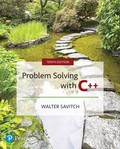
Write a
bool isLeapYear(int year);
This function should return true if year is a leap year and false if it is not. Here is pseudocode to determine a leap year:
leapYear = (year divisible by 400) or (year divisible by 4 and year not divisible by 100))
int getCenturyValue(int year);
This function should take the first two digits of the year (that is. the century), divide by 4. and save the remainder. Subtract the remainder from 3 and return this value multiplied by 2. For example, the year 2008 becomes: (20/4) = 5 with a remainder of 0. 3 - 0 = 3. Return 3*2 = 6.
int getYearValue(int year);
This function computes a value based on the years since the beginning of the century. First, extract the last two digits of the year. For example, 08 is extracted for 2008. Next, factor in leap years. Divide the value from the previous Step by 4 and discard the remainder. Add the two results together and return this value. For example, from 2008 we extract 08. Then (8/4) = 2 with a remainder of 0. Return 2 + 8=10.
int getMonthVa0lue(int month, int year);
This function should return a value based on the table below and will require invoking the isLeapYear function.
| Month | Return Value |
| January | 0 (6 if year is a leap year) |
| February | 3 (2 if year is a leap year) |
| March | 3 |
| April | 6 |
| May | 1 |
| June | 4 |
| July | 6 |
| August | 2 |
| September | 5 |
| October | 0 |
| November | 3 |
| December | 5 |
Finally, to compute the day of the week, compute the sum of the date’s day plus the values returned by getMonthValue, getYearValue, and getCenturyValue. Divide the sum by 7 and compute the remainder. A remainder of 0 corresponds to Sunday, 1 corresponds to Monday, etc., up to 6, which corresponds to Saturday. For example, the date July 4, 2008 should be computed as (day of month) 1 (getMonthValue) 1 (getYearValue) 1 (getCenturyValue) = 4 + 6 + 10 + 6 = 26. 26/7 = 3 with a remainder of 5.
The fifth day of the week corresponds to Friday.
Your program should allow the user to enter any date and output the corresponding day of the week in English.
This program should include a void function named getInput that prompts the user for the date and returns the month, day, and year using pass-by-reference Parameters. You may choose to have the user enter the date’s month as either a number (1–12) or a month name.
Want to see the full answer?
Check out a sample textbook solution
Chapter 5 Solutions
Problem Solving with C++ (10th Edition)
Additional Engineering Textbook Solutions
Starting Out with Programming Logic and Design (5th Edition) (What's New in Computer Science)
SURVEY OF OPERATING SYSTEMS
Concepts Of Programming Languages
Java: An Introduction to Problem Solving and Programming (8th Edition)
Introduction To Programming Using Visual Basic (11th Edition)
Starting Out with C++ from Control Structures to Objects (9th Edition)
- what is a feature in the Windows Server Security Compliance Toolkit, thank you.arrow_forwardYou will write a program that allows the user to keep track of college locations and details about each location. To begin you will create a College python class that keeps track of the csollege's unique id number, name, address, phone number, maximum students, and average tuition cost. Once you have built the College class, you will write a program that stores College objects in a dictionary while using the College's unique id number as the key. The program should display a menu in this order that lets the user: 1) Add a new College 2) Look up a College 4) Delete an existing College 5) Change an existing College's name, address, phone number, maximum guests, and average tuition cost. 6) Exit the programarrow_forwardShow all the workarrow_forward
- Show all the workarrow_forward[5 marks] Give a recursive definition for the language anb2n where n = 1, 2, 3, ... over the alphabet Ó={a, b}. 2) [12 marks] Consider the following languages over the alphabet ={a ,b}, (i) The language of all words that begin and end an a (ii) The language where every a in a word is immediately followed by at least one b. (a) Express each as a Regular Expression (b) Draw an FA for each language (c) For Language (i), draw a TG using at most 3 states (d) For Language (ii), construct a CFG.arrow_forwardQuestion 1 Generate a random sample of standard lognormal data (rlnorm()) for sample size n = 100. Construct histogram estimates of density for this sample using Sturges’ Rule, Scott’s Normal Reference Rule, and the FD Rule. Question 2 Construct a frequency polygon density estimate for the sample in Question 1, using bin width determined by Sturges’ Rule.arrow_forward
- Generate a random sample of standard lognormal data (rlnorm()) for sample size n = 100. Construct histogram estimates of density for this sample using Sturges’ Rule, Scott’s Normal Reference Rule, and the FD Rule.arrow_forwardCan I get help with this case please, thank youarrow_forwardI need help to solve the following, thank youarrow_forward
 C++ for Engineers and ScientistsComputer ScienceISBN:9781133187844Author:Bronson, Gary J.Publisher:Course Technology Ptr
C++ for Engineers and ScientistsComputer ScienceISBN:9781133187844Author:Bronson, Gary J.Publisher:Course Technology Ptr C++ Programming: From Problem Analysis to Program...Computer ScienceISBN:9781337102087Author:D. S. MalikPublisher:Cengage LearningCOMPREHENSIVE MICROSOFT OFFICE 365 EXCEComputer ScienceISBN:9780357392676Author:FREUND, StevenPublisher:CENGAGE L
C++ Programming: From Problem Analysis to Program...Computer ScienceISBN:9781337102087Author:D. S. MalikPublisher:Cengage LearningCOMPREHENSIVE MICROSOFT OFFICE 365 EXCEComputer ScienceISBN:9780357392676Author:FREUND, StevenPublisher:CENGAGE L EBK JAVA PROGRAMMINGComputer ScienceISBN:9781337671385Author:FARRELLPublisher:CENGAGE LEARNING - CONSIGNMENT
EBK JAVA PROGRAMMINGComputer ScienceISBN:9781337671385Author:FARRELLPublisher:CENGAGE LEARNING - CONSIGNMENT Microsoft Visual C#Computer ScienceISBN:9781337102100Author:Joyce, Farrell.Publisher:Cengage Learning,Programming Logic & Design ComprehensiveComputer ScienceISBN:9781337669405Author:FARRELLPublisher:Cengage
Microsoft Visual C#Computer ScienceISBN:9781337102100Author:Joyce, Farrell.Publisher:Cengage Learning,Programming Logic & Design ComprehensiveComputer ScienceISBN:9781337669405Author:FARRELLPublisher:Cengage





